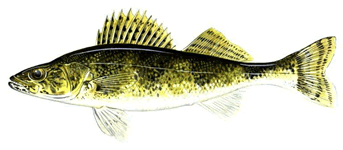Back to Previous Page
SAUGEYE

At-a-Glance
- Scientific Name: Stizostedion vitreum x Stizostedion canadense
- Found in Illinois: Mainly in northern Illinois
- State Average:
- State Record: 10 lbs/13.6 oz (2024)
- Best Lures: Jigs tipped with minnows, night crawlers, leeches, deep-diving crankbaits and spoons
Saugeye rarely forage above the bottom, so baits designed to be positioned on and/or dragged along the bottom are the best bet for catching Saugeye. Jigs tipped with minnows, night crawlers, or leeches are often most effective, particularly in the early spring. Deep-diving crankbaits and spoons can also be used. Unlike Walleye, Saugeye can often be found in small bays containing abundant weed and/or woody cover, places typically more associated with such fish as largemouth bass.
Habitat:The habitat preferences of Saugeye generally line up closer to those of Sauger than to those of Walleye. Saugeye are more tolerant of warm, "dirty" water than walleyes, and they can be found in shallow, turbid areas containing dense plant cover. While Saugeye spend most of their time holding near the bottom, they can also be found taking cover beneath lily pads and other large, emergent plants.
Feeding and Habits: Similar to their "parental" species, Sauger and Walleye, Saugeye feed primarily on benthic invertebrates, worms, and leeches when young, then transition to a diet based around smaller fish as they age. While Saugeye are unlikely to reach the full size of a walleye, they grow faster when young and reach angleable lengths earlier.
Reproduction: Like Sauger, Saugeye are noted for the long runs they make when the spawning season arrives. Saugeyes are fertile (unlike many other hybrids) and are capable of reproducing with either Sauger or Walleye. Spawning takes place in the upstream regions of rivers in the early spring; where dams are present, Saugeyes (as well as Sauger and Walleye where the three are conspecific) may aggregate right below dams to spawn. Eggs are adhesive, and are typically laid on rocky substrates where they are fertilized by males. Following the spring spawn, Saugeye return downstream to their original location in the main channels of large rivers or to connected lakes.



